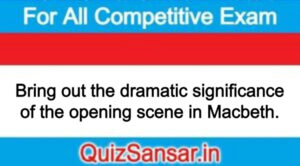
Bring out the dramatic significance of the opening scene in Macbeth.
Bring out the dramatic significance of the opening scene in Macbeth.
Ans.
1. Introduction
The opening scene of Macbeth is unusually brief, but it is a very significant one. In it we find three Witches meeting on a desert heath and talking to one another. In fact, they exchange a few words, and through that medium pass on some significant information. They appear in thunder an lightning. They just give us a hint that they are interested in meeting Macbeth who is at present engaged in a fierce fighting. What is most interesting about this scene is that at the end of their short dialogue the Witches declare their ghastly creed that what is fair in the human world is foul to them and what is foul there is fair to them Thus there is a world of topsy-turvy morality. After this they all of a sudden disappear in the foul foggy atmosphere.
2. Its authenticity
There are some critics who do not think that this scene is genuinely Shakespearean. Some even go to the extreme of asserting that this scene is an addition or interpolation effected later on and that the play should properly open at what is now the second scene of the first act. In the opinion of Seymour, for example, the Witches seem to have been introduced here for no other purpose than to inform us that they are to meet again. He, therefore, considers the scene not only spurious but also harmful to the dramatic interest. According to some others, the scene is not only spurious but also poor and pointless. It is supposed to be thoroughly un-Shakespearean. In spite of such strong opinions, the scene is not only genuine but it is highly significant for several reasons which we shall now try to understand.
3. Its significance
The opening scene of Macbeth is extraordinary. It is exceptionally brief. No other tragedy of Shakespeare has so brief an opening. But more than for its brevity, the scene is remarkable for its lasting effect on the reader’s imagination. As an exposition of a terrible tragedy the scene is perfectly appropriate and successful. It has all the elements that make it an integral part of the play. If we remove this scene, we shall be removing that very scene which prepares us for the tragedy that it to come. By introducing the Witches in the very opening scene of the play, Shakespeare attunes the minds of his audience to the high tragic tone so that they may be prepared for the precipitate action of murder that takes place in the early part of the play. The scene is thoroughly Shakespearean. It is brief and to the point. The Witches statement at the end of the scene, “Fair is foul and foul is fair”, is echo in Macbeth’s first utterance, “So foul and fair a day I have not seen.” The opening scene may be linked with yet another scene of the play. In the opening scene the Witches propose to meet Macbeth on a lonely heath while he is returning from the battle field. In a later scene (Act, IV Scene I) it is Macbeth himself who goes to meet an consult the Witches. The temptation of evil symbolized by the Witches is thus a unifying factor in both these scenes. In this way we can say that the opening scene is an integral part of the play, Macbeth.
The opening scene also strikes the keynote of the tragedy. According to Coleridge, “the true reason for the first appearance of the Witches is to strike the keynote of the character of the whole drama. The Witches appear in a barren place where evil has obtained the mastery of things. They also appear amid the storm which is perhaps created by magic, like the one in The Tempest, and this storm is symbolic of that moral storm which has baffled Duncan’s Scotland at preserve and of the still greater storm to come later.” Their enigmatic words “Fair is foul and foul is fair” represent a reversal of human values in a world dominated by the forces of evil. This, too, is going to be a reality in Scotland under Macbeth’s tyrannical regime. Evil is good for the Witches and so it becomes for Macbeth later. The presence of the Witches in the play creates and intensifies a peculiar atmosphere of mystery, enchantment, darkness, and fatality.
This brief scene also helps to set the atmosphere of the play. It introduces the forces that control its action. The Witches in the opening scene serve to envelop the play in an atmosphere of gloom and desolation. They disclose their plan to meet Macbeth on a desert heath as he returns victorious from the battle. This at once arouses our interest in the character of the hero. Their avowal of a ghostly creed immediately makes us see that they are the representatives of evil in this world. They symbolize the reversal of the moral order. Their interest in Macbeth suggests that they are going to cast their evil influence on him. This, in turn, will affect the future course of events in the play. Thus the opening scene makes us wait in suspense for the arrival of the hero and to see how he reacts to the forces of evil.
Thus the opening scene of Macbeth is very appealing. It is an integral part of the play. There is no ground at all for the belief that it is spurious.
-
Write the critical appreciation of the poem No. 12 entitled Far Below Flowed.
-
Write the critical appreciation of the poem No. 11 entitled Leave this Chanting.






